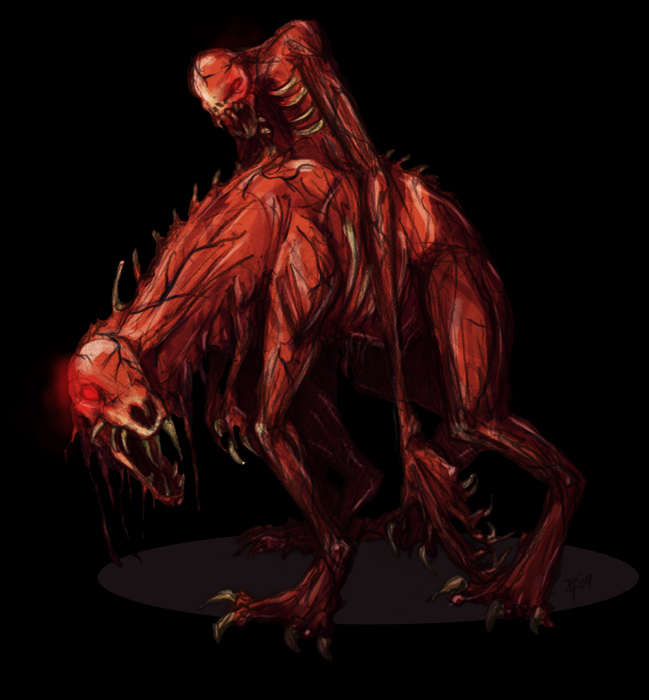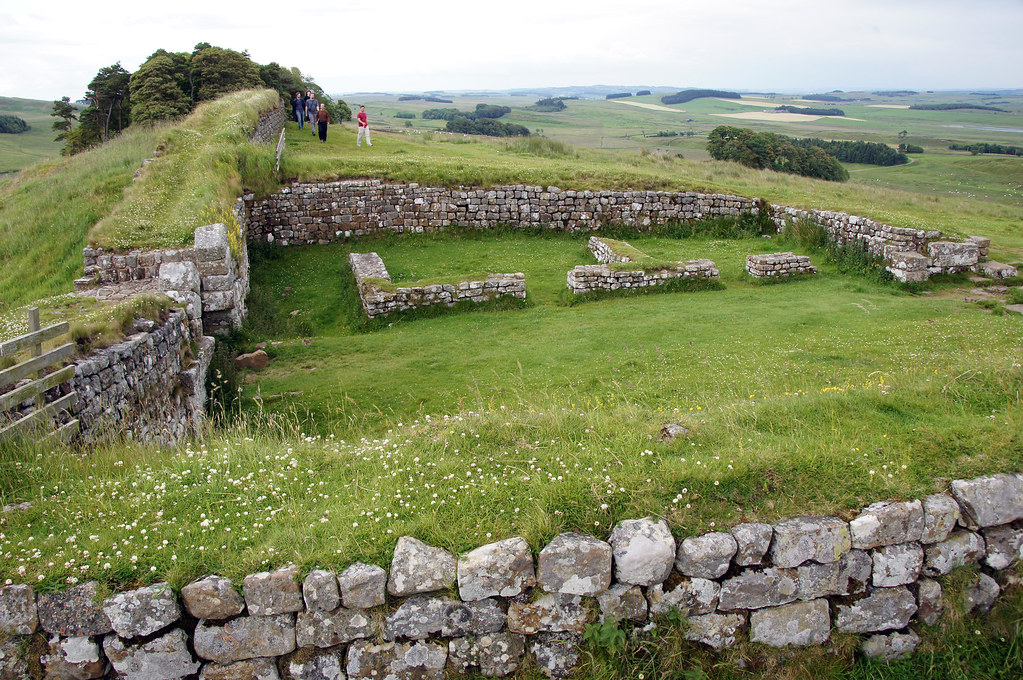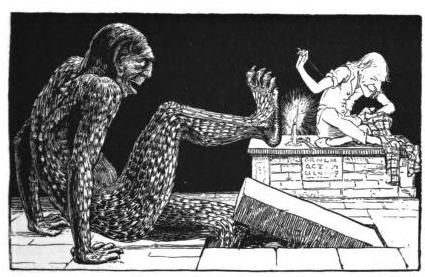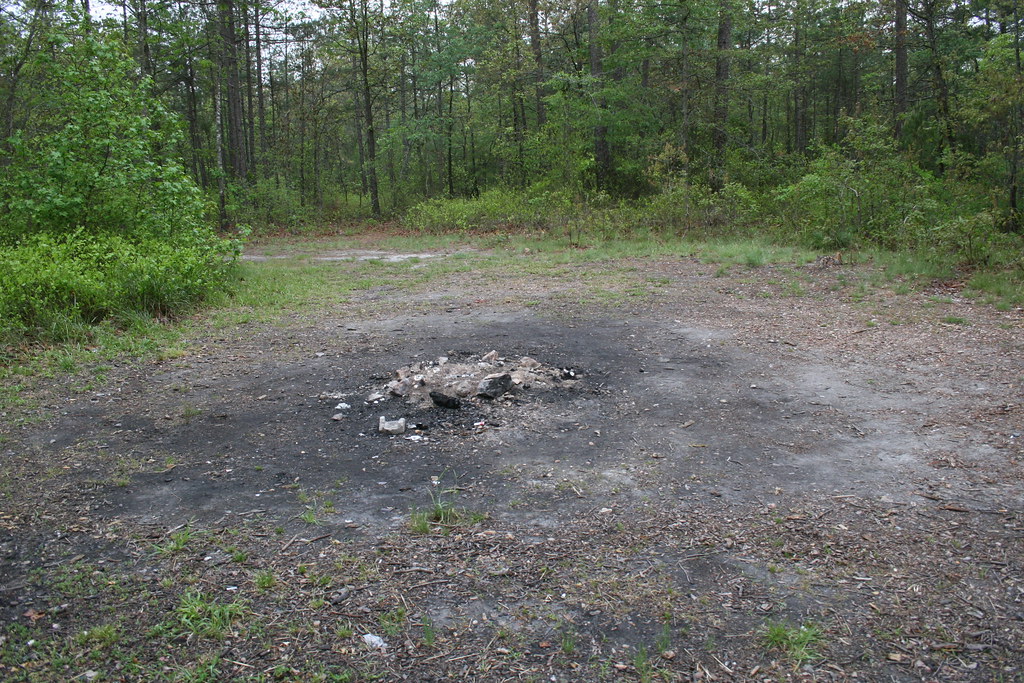Best of the Friday Fun Facts: Collection #11

Here are this week's Friday Fun Facts about Diana Gabaldon's books. In honor of Halloween (or Samhain, or All Hallows' Eve), this is a collection of my favorite spooky, mysterious, and/or Halloween-related items from previous FFF posts. Hope you enjoy it!

1) Here's one artist's conception of what a Nuckelavee looks like. (Drawing by Verdego at DeviantArt.com.) Click on the picture for a bigger view.
“Jem,” she said, the thought occurring as they came even with him. “Do you know what a Nuckelavee is?”The following description of the Nuckelavee, from a site on the folklore of the Orkney Islands, sounds very close to the way the creature is described in ECHO:
Jem’s eyes went huge, and he clapped his hands over Mandy’s ears. Something with a hundred cold tiny feet skittered up Brianna’s back.
“Aye,” he said, his voice small and breathless.
“Who told you about it?” she asked, keeping her voice calm. She’d kill Annie MacDonald, she thought.
But Jem’s eyes slid sideways, as he glanced involuntarily over her shoulder, up at the broch.
“He did,” he whispered.
“He?” she said sharply, and grabbed Mandy by the arm as the little girl wiggled free and turned furiously on her brother. “Don’t kick your brother, Mandy! Who do you mean, Jemmy?”
Jem’s lower teeth caught his lip.
“Him,” he blurted. “The Nuckelavee.”
(From AN ECHO IN THE BONE by Diana Gabaldon, chapter 21, "The Minister's Cat". Copyright© 2009 by Diana Gabaldon. All rights reserved.)
From the few recorded descriptions of the Nuckelavee, we learn that his head was similar to that of a man only "ten times larger". He had an incredibly wide mouth that jutted out like a pig's snout and a single red eye that burned with a red flame.Definitely not! <shudder> I can certainly understand why eight-year-old Jem was scared out of his wits at the prospect of encountering such a creature.
Hairless, his body was also skinless, its entire surface appearing like raw and living flesh. It was said that his thick, black blood could be seen coursing through his veins, as his sinewy muscles writhed with every movement he made. His long ape-like arms hung down to the ground and from his gaping mouth spewed a foul, black reek.
All in all, not a pleasant sight to encounter on some lonely stretch of coastline.

2) The fugu fish (pictured above, from Wikipedia) is apparently an essential ingredient in the creation of zombies, as we learned in this conversation between Lord John and Geillis Abernathy:
"Poison. That would be the afile powder? What sort of poison is it, do you know?”Fugu fish is a delicacy in Japan, but it's dangerous! According to Wikipedia, the fugu or pufferfish contains a deadly toxin called tetrodotoxin or TTX:
Seeing the spark in her eye, he thanked the impulse that had led him to add, “Do you know?” to that question--for if not for pride, he thought she might not have told him. As it was, she shrugged and answered offhand.
“Oh...herbs. Ground bones--bits o’ other things. But the main thing, the one thing ye must have, is the liver of a fugu fish.”
He shook his head, not recognizing the name. “Describe it, if you please.” She did; from her description, he thought it must be one of the odd puffer fish that blew themselves up like bladders if disturbed. He made a silent resolve never to eat one.
(From "A Plague of Zombies" by Diana Gabaldon. Copyright© 2011 by Diana Gabaldon. All rights reserved.)
TTX is roughly 100 times more poisonous than potassium cyanide. Fish poisoning by consumption of members of the order Tetraodontiformes is extremely serious. The organs (e.g. liver) of the pufferfish can contain levels of tetrodotoxin sufficient to produce paralysis of the diaphragm and, through this mechanism, death due to respiratory failure. Toxicity varies between species and at different seasons and geographic localities, and the flesh of many pufferfish may not be dangerously toxic. It is not always fatal; but at near-lethal doses, it can leave a person in a state of near-death for several days, while the person remains conscious.Here's an article with more information about the effects of fugu poisoning, including some discussion of why anyone would ingest this stuff deliberately.
If you're interested in learning more about this phenomenon, check out THE SERPENT AND THE RAINBOW by Wade Davis (or the movie of the same name). Diana told me that she used that book in her research for "Plague of Zombies". I haven't read it myself. Are any of you familiar with it?

3) This is Milecastle 37 of Hadrian's Wall, in Northumbria, England. Click on the photo for a bigger view. (Photo credit: Sharon & Rick, on Flickr.) You may recall that Jerry MacKenzie flew over this spot on October 31, 1941, just before his plane went down.
Mile-castle 37.If you want to get a sense of what Jerry saw from the cockpit that day in 1941, here's an aerial view of Mile-castle 37, from Google Maps. For more about the milecastles, look here.
A stone rectangle, attached to Hadrian's Wall like a snail on a leaf. The old Roman legions had made these small, neat forts to house the garrisons that guarded the wall. Nothing left now but the outline of the foundation, but it made a good target.
He circled once, calculating, then dived and roared over it at an altitude of maybe fifty feet, cameras clunking like an army of stampeding robots. Pulled up sharp and hared off, circling high and fast, pulling out to run for the imagined border, circling up again…and all the time his heart thumped and the sweat ran down his sides, imagining what it would be like when the real day came.
(From "A Leaf on the Wind of All Hallows" by Diana Gabaldon. Copyright© 2010 by Diana Gabaldon. All rights reserved.)

4) When I first read VOYAGER, I was baffled by Claire and Roger's conversation about an old fairy tale:
"‘See’st thou this great gray head, with jaws which have no meat?’” Roger quoted. “You know the story? The little tailor who spent the night in a haunted church, and met the hungry ghost?”The story they're referring to is called "The Sprightly Tailor", by Joseph Jacobs (1854-1916). You can read the full story here.
“I do. I think if I’d heard that outside my window, I’d have spent the rest of the night hiding under the bedclothes."
(From VOYAGER by Diana Gabaldon, Chapter 22, "All Hallows' Eve". Copyright© 1994 by Diana Gabaldon. All rights reserved.)

5) Diana Gabaldon has said that the Devil's Tramping Ground in rural Chatham County, North Carolina, was the inspiration for the barren spot inside the rhododendron hell that Roger discovered in DRUMS OF AUTUMN.
His head and shoulders protruded into a clear space. Not merely clear, but empty. Eagerly, he wriggled forward, out of the claustrophobic grip of the rhododendrons.
He was standing in an open space, facing a cliff wall that rose on the far side of a small clearing. It really was a clearing, too; nothing at all grew in the soft dirt beneath his feet. Astonished, he turned slowly round, gulping great lungfuls of cold, sharp air.
“My God in heaven,” he said softly, aloud. The clearing was roughly oval in shape, ringed by standing stones, with one end of the oval closed by the cliff face. The stones were evenly spaced around the ring, a few of them fallen, a couple more dislodged from their places by the press of roots and stems behind them. He could see the dense black mass of the rhododendrons, showing between and above the stones--but not one plant grew within the perimeter of the ring.
(From DRUMS OF AUTUMN by Diana Gabaldon, Chapter 51, "Betrayal". Copyright© 1997 by Diana Gabaldon. All rights reserved.)

Here's another view. (Photo credit: opus2008, on Flickr.) According to this site,
The Devil's Tramping Ground is a mysterious, perfectly round and absolutely barren circle about forty feet in diameter in the pine woods of Chatham County. Not a tree, not flower, no lowly weed or even a single blade of grass will grow in the limits of the circle. Seed sowed there refuse to sprout. Any vegetation transplanted there will wither and die.Happy Halloween, everyone! Be careful if you go near any standing stones, and be sure to carry a wee gemstone, just in case. <g>
And, what's even more strange, any object left in the circle at dusk will have been violently moved outside its bounds by dawn.
I hope you enjoyed this 11th installment of the Best of the Friday Fun Facts! Here are the previous collections:
Best of the Friday Fun Facts: Collection #1
Best of the Friday Fun Facts: Collection #2
Best of the Friday Fun Facts: Collection #3
Best of the Friday Fun Facts: Collection #4
Best of the Friday Fun Facts: Collection #5
Best of the Friday Fun Facts: Collection #6
Best of the Friday Fun Facts: Collection #7
Best of the Friday Fun Facts: Collection #8
Best of the Friday Fun Facts: Collection #9
Best of the Friday Fun Facts: Collection #10
Look here to see all of my Friday Fun Facts blog posts.







Comments